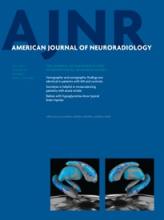Research ArticleBrain
Open Access
The Effect of Pulse Sequence Parameters and Contrast Agent Dose on Percentage Signal Recovery in DSC-MRI: Implications for Clinical Applications
J.L. Boxerman, E.S. Paulson, M.A. Prah and K.M. Schmainda
American Journal of Neuroradiology July 2013, 34 (7) 1364-1369; DOI: https://doi.org/10.3174/ajnr.A3477
J.L. Boxerman
aFrom the Department of Diagnostic Imaging (J.L.B.), Rhode Island Hospital, Providence, Rhode Island
bAlpert Medical School of Brown University (J.L.B.), Providence, Rhode Island
E.S. Paulson
cDepartments of Radiation Oncology (E.S.P.)
dRadiology (E.S.P., M.A.P., K.M.S.)
M.A. Prah
dRadiology (E.S.P., M.A.P., K.M.S.)
K.M. Schmainda
dRadiology (E.S.P., M.A.P., K.M.S.)
eBiophysics (K.M.S.), Medical College of Wisconsin, Milwaukee, Wisconsin.

REFERENCES
- 1.↵
- 2.↵
- Barajas RF,
- Chang JS,
- Sneed PK,
- et al
- 3.↵
- Huang J,
- Wang AM,
- Shetty A,
- et al
- 4.↵
- Barajas RF Jr.,
- Chang JS,
- Segal MR,
- et al
- 5.↵
- Cha S,
- Lupo JM,
- Chen MH,
- et al
- 6.↵
- Liao W,
- Liu Y,
- Wang X,
- et al
- 7.↵
- Mangla R,
- Kolar B,
- Zhu T,
- et al
- 8.↵
- 9.↵
- Boxerman JL,
- Schmainda KM,
- Weisskoff RM
- 10.↵
- Boxerman JL,
- Prah DE,
- Paulson ES,
- et al
- 11.↵
- Levin JM,
- Kaufman MJ,
- Ross MH,
- et al
- 12.↵
- Paulson ES,
- Schmainda KM
- 13.↵
- 14.↵
- Law M,
- Yang S,
- Babb JS,
- et al
- 15.↵
- Lee MC,
- Cha S,
- Chang SM,
- et al
- 16.↵
- Vonken EP,
- van Osch MJ,
- Bakker CJ,
- et al
- 17.↵
- Uematsu H,
- Maeda M,
- Sadato N,
- et al
- 18.↵
- Donahue KM,
- Krouwer HG,
- Rand SD,
- et al
- 19.↵
- Schmainda KM,
- Rand SD,
- Joseph AM,
- et al
- 20.↵
- Paulson ES,
- Prah DE,
- Schmainda KM
- 21.↵
- 22.↵
- Boxerman JL,
- Rosen BR,
- Weisskoff RM
In this issue
Advertisement
J.L. Boxerman, E.S. Paulson, M.A. Prah, K.M. Schmainda
The Effect of Pulse Sequence Parameters and Contrast Agent Dose on Percentage Signal Recovery in DSC-MRI: Implications for Clinical Applications
American Journal of Neuroradiology Jul 2013, 34 (7) 1364-1369; DOI: 10.3174/ajnr.A3477
0 Responses
Jump to section
Related Articles
- No related articles found.
Cited By...
- "Synthetic" DSC Perfusion MRI with Adjustable Acquisition Parameters in Brain Tumors Using Dynamic Spin-and-Gradient-Echo Echoplanar Imaging
- Machine learning assisted DSC-MRI radiomics as a tool for glioma classification by grade and mutation status
- Presurgical Identification of Primary Central Nervous System Lymphoma with Normalized Time-Intensity Curve: A Pilot Study of a New Method to Analyze DSC-PWI
- Utility of Percentage Signal Recovery and Baseline Signal in DSC-MRI Optimized for Relative CBV Measurement for Differentiating Glioblastoma, Lymphoma, Metastasis, and Meningioma
- Clinical Value of Vascular Permeability Estimates Using Dynamic Susceptibility Contrast MRI: Improved Diagnostic Performance in Distinguishing Hypervascular Primary CNS Lymphoma from Glioblastoma
- Contrast Leakage Patterns from Dynamic Susceptibility Contrast Perfusion MRI in the Grading of Primary Pediatric Brain Tumors
This article has not yet been cited by articles in journals that are participating in Crossref Cited-by Linking.
More in this TOC Section
Similar Articles
Advertisement











